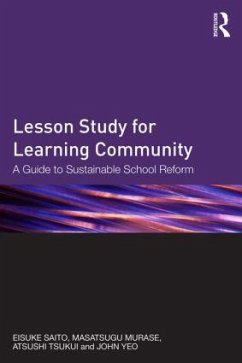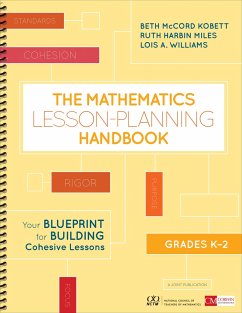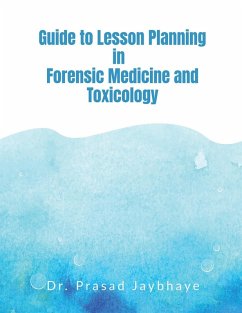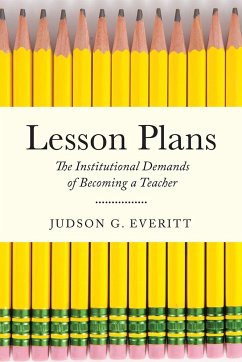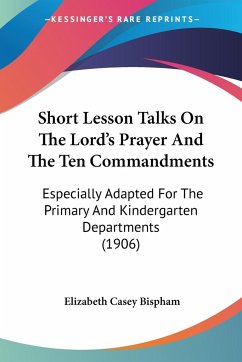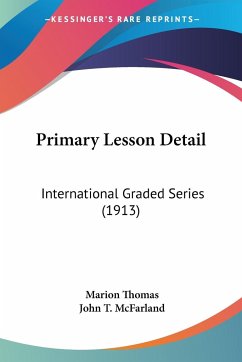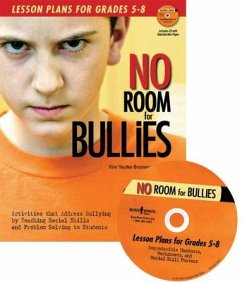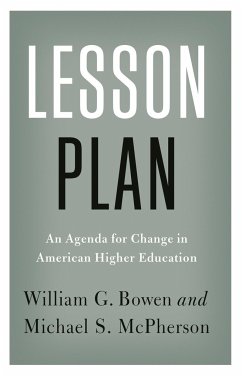
Lesson Planning
A Research-Based Model for K-12 Classrooms
Versandkostenfrei!
Versandfertig in über 4 Wochen
85,99 €
inkl. MwSt.

PAYBACK Punkte
43 °P sammeln!
Are you looking to construct a lesson plan that will help K-12 students master new content, concepts, and skills? Lesson Planning: A Research-based Model for K-12 Classrooms can help by guiding you in the selection of research-based instructional strategies and types of materials designed to consider all learners' needs.
Product Description
Are you looking to construct a lesson plan that will help K-12 students master new content, concepts, and skills? Lesson Planning: A Research-based Model for K-12 Classrooms can help by guiding you in the selection of research-based instructional strategies and types of materials designed to consider all learners' needs.
Part I establishes the theoretical foundations of the ideas used in the lesson planning process.
Part II is a step-by-step guide to developing direct and inquiry-based lesson plans.
Meeting the Needs of all learners - woven throughout each chapter, the authors address the diverse needs of students.
INTASC Standards Correlation Guide appears on the inside front cover to help readers quickly identify the lessons that meet each standard.
Connections to the INTASC Standards are woven throughout each chapter's content and activities.
Unit Connections explain how the chapter's content is used in the development of a unit
Technology in Education (TiE) - a feature throughout the book provide practical help in the lesson planning process including rubric generating sites, lesson plan templates, ideas for lesson activities, and links to useful classroom materials.
Reality Check, a feature in each chapter, provides advice from practicing classroom teachers who represent a range of subjects and grade levels.
Your Turn feature at the end of each chapter helps you create your own standards-based lesson plan in both direct and indirect instruction formats.
Features + Benefits
Part I establishes the theoretical foundations of the ideas used in the lesson planning process.
Part II is a step-by-step guide to developing direct and inquiry-based lesson plans.
Meeting the Needs of all learners - woven throughout each chapter, the authors address the diverse needs of students.
INTASC Standards Correlation Guide appears on the inside front cover to help readers quickly identify the lessons that meet each standard.
Connections to the INTASC Standards are woven throughout each chapter's content and activities.
Unit Connections explain how the chapter's content is used in the development of a unit
Technology in Education (TiE) - a feature throughout the book provide practical help in the lesson planning process including rubric generating sites, lesson plan templates, ideas for lesson activities, and links to useful classroom materials.
Reality Check, a feature in each chapter, provides advice from practicing classroom teachers who represent a range of subjects and grade levels.
Your Turn feature at the end of each chapter helps you create your own standards-based lesson plan in both direct and indirect instruction formats.
Backcover
Are you looking to construct a lesson plan that will help K-12 students master new content, concepts, and skills? Lesson Planning: A Research-based Model for K-12 Classrooms can help by guiding you in the selection of research-based instructional strategies and types of materials designed to consider all learners' needs.
Part I establishes the theoretical foundations of the ideas used in the lesson planning process.
Part II is a step-by-step guide to developing direct and inquiry-based lesson plans.
Meeting the Needs of all learners - woven throughout each chapter, the authors address the diverse needs of students.
INTASC Standards Correlation Guide appears on the inside front cover to help readers quickly identify the lessons that meet each standard.
Connections to the INTASC Standards are woven throughout each chapter's content and activities.
Unit Connections explain how the chapter's content is used in the development of a unit
Technology in Education (TiE) - a feature throughout the book provide practical help in the lesson planning process including rubric generating sites, lesson plan templates, ideas for lesson activities, and links to useful classroom materials.
Reality Check, a feature in each chapter, provides advice from practicing classroom teachers who represent a range of subjects and grade levels.
Your Turn feature at the end of each chapter helps you create your own standards-based lesson plan in both direct and indirect instruction formats.
Instructional Strategies List
Preface
PART I: CONCEPTUAL FOUNDATIONS FOR PLANNING A LESSON
Chapter 1: Planning is Necessary
Planning is Professional Decision-Making
Teacher Accountability: Past and Present
Planning as a Road Trip Analogy
Reasons for Planning
Lesson Focus
Remaining Focused During Instruction
Selecting Appropriate Materials and Strategies
Incorporates Academic Standards
Classroom Management
Reflective Practitioner
Long Range Planning
Daily Lesson Plans
Interdisciplinary Thematic Unit
In Summary
Your Turn:
Activity: Reflections on Planning
Bibliography
Chapter 2: Teaching is Informed Decision Making
Making Decisions: Experienced and Expert Teachers
The Importance of a Personal Philosophy of Teaching
Philosophy: A K-12 Lesson Planning Model That Works
Constructivism
Context
Commitment
Content
In Summary
Your Turn:
Activity 1: Your Beliefs
Activity 2: Your Philosophy
Bibliography
PART II: STRUCTURAL FOUNDATIONS OF A LESSON PLAN
Chapter 3: Identifying a Topic and Academic Standards
Identifying Topics
Identifying Academic Standards
Standards and Educational Reform
National Standards
State Standards
Identify a Topic and Standards for a Lesson
In Summary
Your Turn:
Activity 1: Your State Standards
Activity 2: Topic Identification
Activity 3: Select and Align a Topic with State Standards
Activity 4: Reflection
Bibliography
Chapter 4: Writing Lesson Goals and Objectives
Goals and Objectives
Purpose for Writing Goals and Objectives
Defining Goals and Objectives
Approaches to Writing Lesson Objectives
Behavioral Objectives
Goals Objectives
Instructional Objectives
Standards-based Lessons:
Using Academic Standards to Write Objectives
In Summary
Your Turn:
Activity 1: Distinguishing Between Goals and Objectives and Identifying Taxonomy Levels
Activity 2: Writing an Instructional Objective
Activity 3: Reflection
Biblography
Chapter 5: Designing Formative and Summative Assessments
The Importance of Assessment
Reasons for Classroom Assessment
Assessment and Evaluation
Types of Assessment
The Assessment Process: Pre-assessment, Formative, and Summative Assessment
Evaluation
Creating a Rubric
A Process for Measuring Teacher Impact
In Summary
Your Turn:
Activity 1: Creating Your Lesson's Pre- and Post-Assessments
Activity 2: Create a Rubric
Activity 3: Creating a Formative Assessment
Activity 4a: Differentiating Your Lesson's Product by Readiness
Activity 4b: Differentiating Your Lesson's Product by Interest
Activity 4c: Differentiating Your Lesson's Product by Learner
Activity 5: Reflection
Bibliography
Chapter 6: Choosing the Lesson Content and Instructional Strategies
A Highly Qualified Teacher in Every Room
Understanding Context: The Learners
What is Differentiation?
Understanding Differentiation: Important Terms Defined
Content
Process
Product
Student Readiness
Student Interest
Learning Profile
Intelligence Preference
Environment
Organizational Considerations
Understanding Content
Informational
Instructional
In Summary
Your Turn:
Activity 1: Identify Your Informational Sources
Activity 2: Identify Your Instructional Sources
Activity 3: Creating a Lesson Plan Annotated Bibliography
Activity 4: Collaboration
Activity 5: Reflection
Bibliography
Chapter 7: Selecting Lesson Materials
The Next Step: Selecting Materials
Materials Defined
&n
Product Description
Are you looking to construct a lesson plan that will help K-12 students master new content, concepts, and skills? Lesson Planning: A Research-based Model for K-12 Classrooms can help by guiding you in the selection of research-based instructional strategies and types of materials designed to consider all learners' needs.
Part I establishes the theoretical foundations of the ideas used in the lesson planning process.
Part II is a step-by-step guide to developing direct and inquiry-based lesson plans.
Meeting the Needs of all learners - woven throughout each chapter, the authors address the diverse needs of students.
INTASC Standards Correlation Guide appears on the inside front cover to help readers quickly identify the lessons that meet each standard.
Connections to the INTASC Standards are woven throughout each chapter's content and activities.
Unit Connections explain how the chapter's content is used in the development of a unit
Technology in Education (TiE) - a feature throughout the book provide practical help in the lesson planning process including rubric generating sites, lesson plan templates, ideas for lesson activities, and links to useful classroom materials.
Reality Check, a feature in each chapter, provides advice from practicing classroom teachers who represent a range of subjects and grade levels.
Your Turn feature at the end of each chapter helps you create your own standards-based lesson plan in both direct and indirect instruction formats.
Features + Benefits
Part I establishes the theoretical foundations of the ideas used in the lesson planning process.
Part II is a step-by-step guide to developing direct and inquiry-based lesson plans.
Meeting the Needs of all learners - woven throughout each chapter, the authors address the diverse needs of students.
INTASC Standards Correlation Guide appears on the inside front cover to help readers quickly identify the lessons that meet each standard.
Connections to the INTASC Standards are woven throughout each chapter's content and activities.
Unit Connections explain how the chapter's content is used in the development of a unit
Technology in Education (TiE) - a feature throughout the book provide practical help in the lesson planning process including rubric generating sites, lesson plan templates, ideas for lesson activities, and links to useful classroom materials.
Reality Check, a feature in each chapter, provides advice from practicing classroom teachers who represent a range of subjects and grade levels.
Your Turn feature at the end of each chapter helps you create your own standards-based lesson plan in both direct and indirect instruction formats.
Backcover
Are you looking to construct a lesson plan that will help K-12 students master new content, concepts, and skills? Lesson Planning: A Research-based Model for K-12 Classrooms can help by guiding you in the selection of research-based instructional strategies and types of materials designed to consider all learners' needs.
Part I establishes the theoretical foundations of the ideas used in the lesson planning process.
Part II is a step-by-step guide to developing direct and inquiry-based lesson plans.
Meeting the Needs of all learners - woven throughout each chapter, the authors address the diverse needs of students.
INTASC Standards Correlation Guide appears on the inside front cover to help readers quickly identify the lessons that meet each standard.
Connections to the INTASC Standards are woven throughout each chapter's content and activities.
Unit Connections explain how the chapter's content is used in the development of a unit
Technology in Education (TiE) - a feature throughout the book provide practical help in the lesson planning process including rubric generating sites, lesson plan templates, ideas for lesson activities, and links to useful classroom materials.
Reality Check, a feature in each chapter, provides advice from practicing classroom teachers who represent a range of subjects and grade levels.
Your Turn feature at the end of each chapter helps you create your own standards-based lesson plan in both direct and indirect instruction formats.
Instructional Strategies List
Preface
PART I: CONCEPTUAL FOUNDATIONS FOR PLANNING A LESSON
Chapter 1: Planning is Necessary
Planning is Professional Decision-Making
Teacher Accountability: Past and Present
Planning as a Road Trip Analogy
Reasons for Planning
Lesson Focus
Remaining Focused During Instruction
Selecting Appropriate Materials and Strategies
Incorporates Academic Standards
Classroom Management
Reflective Practitioner
Long Range Planning
Daily Lesson Plans
Interdisciplinary Thematic Unit
In Summary
Your Turn:
Activity: Reflections on Planning
Bibliography
Chapter 2: Teaching is Informed Decision Making
Making Decisions: Experienced and Expert Teachers
The Importance of a Personal Philosophy of Teaching
Philosophy: A K-12 Lesson Planning Model That Works
Constructivism
Context
Commitment
Content
In Summary
Your Turn:
Activity 1: Your Beliefs
Activity 2: Your Philosophy
Bibliography
PART II: STRUCTURAL FOUNDATIONS OF A LESSON PLAN
Chapter 3: Identifying a Topic and Academic Standards
Identifying Topics
Identifying Academic Standards
Standards and Educational Reform
National Standards
State Standards
Identify a Topic and Standards for a Lesson
In Summary
Your Turn:
Activity 1: Your State Standards
Activity 2: Topic Identification
Activity 3: Select and Align a Topic with State Standards
Activity 4: Reflection
Bibliography
Chapter 4: Writing Lesson Goals and Objectives
Goals and Objectives
Purpose for Writing Goals and Objectives
Defining Goals and Objectives
Approaches to Writing Lesson Objectives
Behavioral Objectives
Goals Objectives
Instructional Objectives
Standards-based Lessons:
Using Academic Standards to Write Objectives
In Summary
Your Turn:
Activity 1: Distinguishing Between Goals and Objectives and Identifying Taxonomy Levels
Activity 2: Writing an Instructional Objective
Activity 3: Reflection
Biblography
Chapter 5: Designing Formative and Summative Assessments
The Importance of Assessment
Reasons for Classroom Assessment
Assessment and Evaluation
Types of Assessment
The Assessment Process: Pre-assessment, Formative, and Summative Assessment
Evaluation
Creating a Rubric
A Process for Measuring Teacher Impact
In Summary
Your Turn:
Activity 1: Creating Your Lesson's Pre- and Post-Assessments
Activity 2: Create a Rubric
Activity 3: Creating a Formative Assessment
Activity 4a: Differentiating Your Lesson's Product by Readiness
Activity 4b: Differentiating Your Lesson's Product by Interest
Activity 4c: Differentiating Your Lesson's Product by Learner
Activity 5: Reflection
Bibliography
Chapter 6: Choosing the Lesson Content and Instructional Strategies
A Highly Qualified Teacher in Every Room
Understanding Context: The Learners
What is Differentiation?
Understanding Differentiation: Important Terms Defined
Content
Process
Product
Student Readiness
Student Interest
Learning Profile
Intelligence Preference
Environment
Organizational Considerations
Understanding Content
Informational
Instructional
In Summary
Your Turn:
Activity 1: Identify Your Informational Sources
Activity 2: Identify Your Instructional Sources
Activity 3: Creating a Lesson Plan Annotated Bibliography
Activity 4: Collaboration
Activity 5: Reflection
Bibliography
Chapter 7: Selecting Lesson Materials
The Next Step: Selecting Materials
Materials Defined
&n
Are you looking to construct a lesson plan that will help K-12 students master new content, concepts, and skills? Lesson Planning: A Research-based Model for K-12 Classrooms can help by guiding you in the selection of research-based instructional strategies and types of materials designed to consider all learners' needs.



